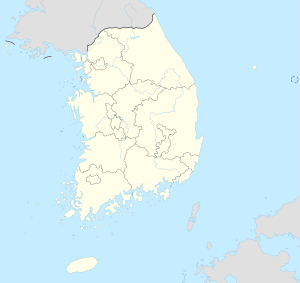Gochang
| Gochang-gun | |||
|---|---|---|---|
| Korean alphabet : | 고창군 | ||
| Chinese characters : | 高敞 郡 | ||
| Revised Romanization : | Gochang-gun | ||
| McCune-Reischauer : | Koch'ang-gun | ||
| Basic data | |||
| Province : | Jeollabuk-do | ||
| Coordinates : | 35 ° 26 ' N , 126 ° 42' E | ||
| Surface: | 606.90 km² | ||
| Residents: | 72,996 (as of: 2001) | ||
| Population density : | 120 inhabitants per km² | ||
| Structure: | 1 eup, 13 myeon | ||
| map | |||
|
|||
Gochang County ( kor. 고창군 , Gochang-gun ) is located in Jeollabuk-do Province and borders the Yellow Sea . The administrative headquarters are in the city of Gochang-eup.
Administrative structure
- Gochang-eup (고창읍)
- Gosu-myeon (고수면)
- Asan-myeon (아산면)
- Mujang-myeon (무장면)
- Gong-eum-myeon (공음면)
- Sangha-myeong (상하면)
- Haeri-myeon (해리면)
- Seongsong (성송면)
- Daesan-myeon (대산면)
- Simwon-myeon (심원면)
- Heungdeok-myeon (흥덕면)
- Seongnae-myeon (성내면)
- Sillim-myeon (신림면)
- Buan-myeon (부안면)
Tourist destinations
The Gochang dolmen sites are located in the district and were included in the UNESCO World Heritage List (Asia and Oceania) in 2000 . There are 447 different types of dolmens in a valley.
In 1979 a provincial park was set up around Mount Seonunsan (336 m), in which the Seonunsa Temple, built in 577, is located.
Fort Gochangeupseong , completed in 1453 and surrounded by a 1684 m long wall, is located in the eastern district .
Symbols
Each South Korean county has certain symbols. Gochang County has the following symbols:
Web links
- Website of the County Gochang (English)

